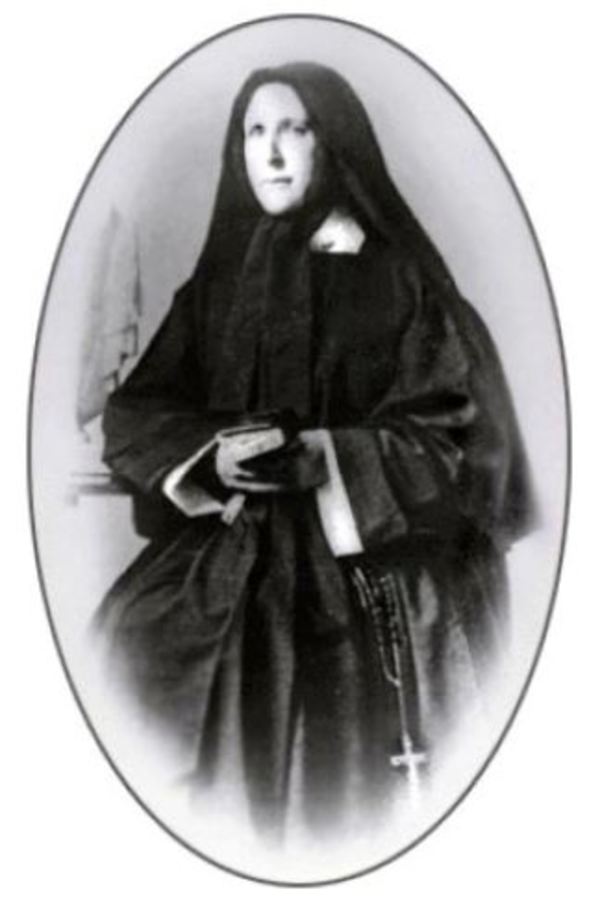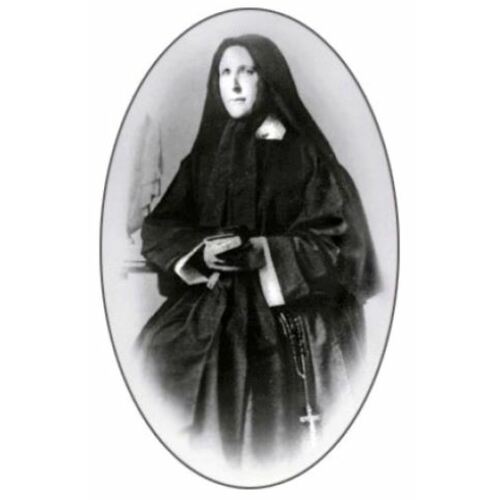
Source: Link
CONWAY, HONORIA, named Mother Mary Vincent, Sister of Charity of Saint John and educator; b. 1815, c. 18 June, in Dover Castle, England, daughter of Michael Conway and Eleanor McCarthy; d. 27 May 1892 in Saint John, N.B.
Honoria Conway was born into an Irish Catholic family of modest means. Her father, following his service with the militia during the Napoleonic Wars, resettled in Ballinasloe, County Galway (Republic of Ireland). Here he sent his three children to a private Catholic school, thus providing them with a good education by the standard of the time.
Honoria’s arrival in British North America appears to have been the product of several events. Two of her mother’s brothers, James and Charles McCarthy, had gone to Nova Scotia in their youth, each achieving prominence in Digby County while establishing a family precedent for transatlantic migration. In 1831 Honoria’s elder sister, Margaret, married Hugh Donnelly, a widower and wool-draper from Athlone, not far from Ballinasloe. Two years later Donnelly went to Saint John, where he became a successful businessman. In 1837 he brought out his family and a daughter from his previous marriage. Honoria and her widowed mother formed part of this extended household.
A business reversal in 1838 forced Donnelly to retire, whereupon he settled in Nova Scotia. Honoria and her mother resided with Mrs Conway’s brother Charles at Salmon River, near Meteghan. Mrs Conway died at Meteghan in 1845 and the Donnellys moved to Rhode Island in 1848. Although no documentation exists for Honoria’s activities from the late 1840s to the early 1850s, it may be speculated that she returned to Saint John, where Donnelly’s daughter resided with her husband, a businessman. It may also be assumed that, in a port city receiving thousands of her indigent countrymen, she became involved in the efforts of Catholic charitable groups to address the needs of an expanding Irish population.
At this time of massive demographic and socio-economic change in Saint John, a new bishop, Thomas Louis Connolly*, was appointed for New Brunswick in 1852. Having come from the archdiocese of Halifax, which encompassed the Meteghan area, he had likely met Honoria Conway. Upon arriving in Saint John, Connolly began immediately to set in place the institutions through which the diocese could nurture its people. An imperative was the securing of permanent personnel to staff a planned Catholic orphanage and operate Catholic schools. To this end Connolly visited the Sisters of Charity of St Vincent de Paul in New York, seeking their services, and was encouraged to hear that, if he could direct young women from Saint John to enter the congregation, the sisters would help him to found a new community in his diocese. In 1853 three young women, Honoria Conway among them, were sent from Saint John to New York.
By early 1854, however, it had become apparent that the New York sisters could not spare members to assume mission responsibilities. This change of heart can be attributed in part, and speculatively, to the demands on the community from within the archdiocese of New York, which was also encountering massive immigration. It seems, moreover, that the young ladies sent from Saint John were in poor health. When a cholera epidemic broke out in Saint John in the summer of 1854, orphaning hundreds of Irish Catholic children, Connolly again went to New York. The Sisters of Charity lamented their inability to spare members of their congregation, but softened their refusal by permitting the bishop to address the noviciate. He invited volunteers to separate from the New York group and to establish in Saint John what would become the first indigenous English-speaking women’s religious congregation in Canada. Four novices volunteered, including Honoria Conway.
On 21 Oct. 1854 these women made their vows as Sisters of Charity of Saint John. They also received the first rules of the community, which, although written by Bishop Connolly, reflected the spirit of those followed by the Sisters of Charity in New York As was the procedure during the early years of diocesan religious congregations, the bishop appointed the superior. Connolly chose Honoria Conway, who at once began to serve as mother general; a few years later she was also named mistress of novices.
Recruits to the new community came gradually and steadily during the first years. They were largely of Irish descent. Honoria Conway, now Mother Mary Vincent, had the pivotal and dual challenge of evolving mechanisms by which a religious could develop according to the rules while meeting the immediate need of running an orphanage and setting up schools. The rudiments of an orphanage were already in place when the sisters assumed responsibility for its operation. The establishing of the schools, however, followed the pattern the core personnel had observed in New York. Thus, in 1854 the sisters opened the first free school in Saint John for the daughters of poor Irish immigrants, and in 1858 an institute requiring fees, St Vincent’s Select School for Girls, was founded. It was hoped that the tuition-based institution would finance the free one. By 1859 there were 27 sisters operating five schools – two in Saint John, one in nearby Portland, one in Fredericton, and one in the Acadian parish of Saint-Basile-de-Madawaska, which enjoyed success even though it was conducted in English.
The operation of the school in Madawaska eventually caused Mother Vincent and the diocesan authorities considerable worry and some embarrassment. In December 1861, for unknown reasons, Sister Mary Stanislaus and two postulants assigned to Saint-Basile defected from the convent and went by “public conveyance” to the newly formed diocese of Chatham, headed by Bishop James Rogers*. Aggravating the situation, Sister Stanislaus, who was one of the original four sisters from New York, began to denigrate the Sisters of Charity in public. Bishop Rogers may have persuaded the defectors from the congregation to ask Mother Vincent to pardon them but she was not so inclined, responding to Rogers that “all concerned in the welfare of the community feel very much the disgrace brought on us by these ladies.” Bishop Connolly, now archbishop of Halifax, concurred, maintaining to Rogers that the errant sisters “never had a vocation.”
Mother Vincent’s generalate ended in 1862. It is not known whether she offered her resignation to the then bishop of Saint John, John Sweeney*, or whether he asked her to resign. Undoubtedly in an era of intense Catholic-Protestant antipathy the last image either the bishop or Mother Vincent wished to be conveyed was that fostered by “the runaway sisters.”
Between 1862 and 1882 Mother Vincent was missioned to Fredericton, where she taught school and served as superior of St Dunstan’s Convent. During this phase of her career, she would have been keenly aware of the controversy surrounding the Common Schools Act of 1871 and its ramifications for the schools operated by the Sisters of Charity, which in effect were deprived of public financial support. Following the resolution of this conflict in 1875, the schools came under the law and the sisters began to prepare themselves for the provincially prescribed licensing examinations.
In 1882 Mother Vincent was transferred back to the motherhouse at St Vincent’s Convent in Saint John. There she witnessed the entrance of the Sisters of Charity into a venture which at once underlined a salient characteristic of urban living in the late 19th century, the displacement of the elderly, and acknowledged a growing need within the Catholic community to care for the infirm. In 1888 the Sisters of Charity opened the first nursing home in the city, the Mater Misericordiae Home.
Mother Vincent spent her last four years in a wheelchair, in striking contrast to the activity of her early career. No doubt as she watched the young novices from her confinement she took pleasure in viewing the growth of the community that she had founded and assisted in shaping, and into which she had welcomed her niece Sister Mary Vincentia Donnelly. Having experienced the struggle over the role of religious communities in New Brunswick’s education system, she would have appreciated the difficulties encountered by her nephew Charles Francis Donnelly, who in 1888–89 successfully represented the archbishop of Boston in the defence of Catholic schools there. Mother Mary Vincent Conway died at the motherhouse on 27 May 1892.
Arch. of the Diocese of Saint John, N.B., John Sweeney papers, James Rogers to Sweeney, 8 Feb. 1862; T. W. Anglin to Sweeney, 6 June 1892. Arch. of the Sisters of Charity of the Immaculate Conception (Saint John), Box 1A, folders 101; 103, Mother Mary Vincent to James Rogers, 17 Dec. 1860, 24 Dec. 1861; 109; 109.01; 109.06; T. L. Connolly, “Rules of the Sisters of Charity, Saint John, N.B.,” 21 Oct. 1854; T. L. Connolly papers, Connolly to the Assoc. for the Propagation of the Faith, 28 Feb. 1859 (typescript); Connolly to James Rogers, 28 Dec. 1861; “Other Saints There Are” (Sisters of Charity necrology). Morning News (Saint John), 16 Aug. 1854. M. G. Hennessey, Honoria Conway: woman of promise; foundress of Sisters of Charity of the Immaculate Conception, Saint John, N.B. ([Saint John], 1985). [(Elizabeth) Legere, named Sister Mary Brendan], Laus Deo! 1854–1954; centenary of the Sisters of Charity of the Immaculate Conception, Saint John, New Brunswick, Canada ([Saint John, 1955]), 35. Loretta MacKinnon, “St. Vincent’s High School, a history of adaptation” (m.ed. thesis, Univ. of N.B., Fredericton, 1985), cc.3–4. K. F. Trombley [Tremblay], Thomas Louis Connolly (1815–1876): the man and his place in secular and ecclesiastical history (Louvain, Belgium, 1983), c.3. Estella Kennedy, “Immigrants, cholera and the Saint John Sisters of Charity: the first ten years of the Sisters of Charity of the Immaculate Conception, Saint John, N.B., 1854–1864,” CCHA Study sessions, 44 (1977): 25–44. E. W. McGahan, “Inside the hallowed walls: convent life through material history,” Material Hist. Bull. (Ottawa), 25 (1987): 1–9.
Cite This Article
Elizabeth W. McGahan, “CONWAY, HONORIA, named Mother Mary Vincent,” in Dictionary of Canadian Biography, vol. 12, University of Toronto/Université Laval, 2003–, accessed January 15, 2026, https://www.biographi.ca/en/bio/conway_honoria_12E.html.
The citation above shows the format for footnotes and endnotes according to the Chicago manual of style (16th edition). Information to be used in other citation formats:
| Permalink: | https://www.biographi.ca/en/bio/conway_honoria_12E.html |
| Author of Article: | Elizabeth W. McGahan |
| Title of Article: | CONWAY, HONORIA, named Mother Mary Vincent |
| Publication Name: | Dictionary of Canadian Biography, vol. 12 |
| Publisher: | University of Toronto/Université Laval |
| Year of publication: | 1990 |
| Year of revision: | 1990 |
| Access Date: | January 15, 2026 |



